Commercial Salmon Fisheries
Southeast Alaska & Yakutat Research: Stikine River Chinook and Sockeye Salmon Research
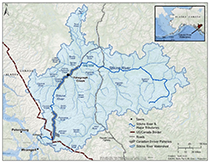
Figure 1. — Click for more Info
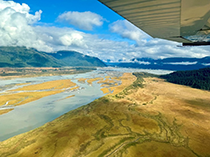
Figure 2. — Click for more Info

Figure 3. — Click for more Info
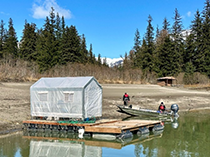
Figure 4. — Click for more Info
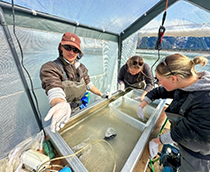
Figure 5. — Click for more Info
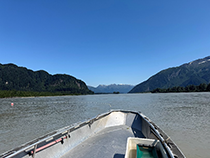
Figure 6. — Click for more Info
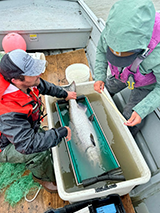
Figure 7. — Click for more Info
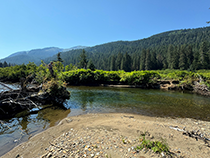
Figure 8. — Click for more Info
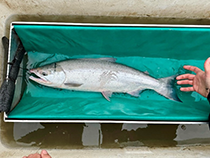
Figure 9. — Click for more Info
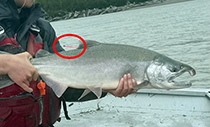
Figure 10. — Click for more Info
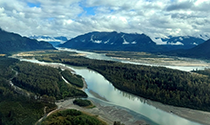
Figure 11. — Click for more Info
Overview
The Stikine River is the largest of Southeast Alaska's transboundary rivers, with headwaters originating in northern British Columbia and Alaska (Figure 1). The Stikine River mainstem is fed by numerous tributaries and flows in a southwesterly direction through Southeast Alaska before discharging into the Pacific Ocean about 5 km north of Wrangell, Alaska. The entire Stikine River drainage covers about 52,000 km, much of which is inaccessible to anadromous fish due to natural barriers (log jams, landslides, etc.). Despite such barriers, the accessible tributaries and side streams within the Stikine River watershed support spawning populations of all five species of Pacific salmon (Figure 2), producing some of the largest runs of Chinook, sockeye, and coho salmon in northern British Columbia and Southeast Alaska.
Stikine River salmon stocks support important commercial, sport, and food/subsistence fisheries on both sides of the U.S./Canada border. The Alaska Department of Fish & Game (ADF&G), Fisheries & Oceans Canada (DFO), and the Tahltan Central Government (TCG) perform cooperative management and research on Stikine River Chinook, sockeye, and coho salmon stocks as dictated by the U.S.-Canada Pacific Salmon Treaty (PST). Beyond cooperative sockeye salmon research and management that began with the signing of the PST in 1985, more focused cooperative Chinook salmon stock assessment began 1996 and the program has extended to include more detailed work on sockeye salmon in 2021 and coho salmon in 2023.
Salmon Stock Assessment Research
Juvenile Chinook Salmon Studies
Since 2000, Chinook salmon smolt have been caught using beach seines set on various gravel bars in the lower Stikine River (Figure 3). After capture, fish are transported to camp (Figure 4) where they are anesthetized prior to being marked with an adipose finclip and tagged with a coded wire tag (CWT; Figure 5). The CWTs are very small (1 mm long) and display unique numbers to identify the tagging location and year. Every healthy Chinook salmon smolt caught during seining has one implanted into its snout. The adipose finclip serves as an external mark to identify the fish as being additionally tagged with a CWT. Tagged smolt are then released unharmed to continue their outmigration to the ocean.
The coded-wire-tagging of Chinook smolt serves as the first of two sampling events in the mark-recapture study. Returning Chinook salmon that were tagged as smolt may be recovered from marine port sampling, inriver fishery sampling, or escapement recovery projects as the second event of the mark-recapture study. The proportion of fish tagged or marked allows scientists to estimate the smolt abundance, adult harvest, marine survival, and total run size of Stikine River Chinook salmon.
Adult Chinook Salmon Sampling
From late May to mid-August, an adult Chinook salmon mark-recapture study occurs on the lower Stikine River at Kakwan Point. In this survey, sampling crews deploy drift gillnets to capture adult Chinook salmon as the first event of the adult mark-recapture study (Figure 6). Each adult Chinook salmon that is captured receives an individually numbered spaghetti tag and is sampled for age, sex, and length data before being released alive (Figure 7). In some years, fish are additionally tagged with radiotags to estimate the relative distribution of large Chinook salmon spawners in the Stikine River watershed and to identify what proportion of the tagged fish migrate above the border. Research has shown that most tagged Chinook salmon successfully migrate above the border where most spawning occurs in the Tahltan River watershed (including Little Tahltan River), the Iskut River watershed, and the Chutine River. To account for potential tag loss, the left axillary fin is clipped to identify that the fish was previously tagged. Tagged adult Chinook are then potentially recaptured in the Canadian commercial inriver fishery, the Little Tahltan River weir, or during foot surveys on the spawning grounds (Figure 8). All adult Chinook salmon captured at all locations are also inspected for missing adipose fins, which may indicate that they were marked as juveniles with a CWT. Fish with a missing adipose fin are scanned for the presence of the CWT. The CWTs recovered from adult Chinook salmon are then read by ADF&G staff at the Mark, Tag, and Age Lab where the release origin of tagged fish can be identified.
Adult Sockeye Salmon
More detailed Stikine River sockeye salmon stock assessment began in 2021 using a genetic mark-recapture study to estimate stock composition and inriver abundance. Stikine River sockeye salmon have historically been subdivided into four stock groups for stock assessment purposes: 1) the wild Tahltan stock, which are those fish originating from naturally spawning sockeye salmon in Tahltan Lake; 2) the enhanced Tahltan stock, which are those fish originating from broodstock collected at Tahltan Lake and subsequently released as fry into Tahltan Lake; 3) the Tuya stock, which are those fish originating from broodstock collected at Tahltan Lake and subsequently released as fry into Tuya Lake (no longer takes place); and 4) the mainstem stock, which are all other natural sockeye salmon populations in the Stikine River. Identifying the stock from which returning sockeye salmon originated allows ADF&G scientists to estimate the inriver abundance of each stock group.
The project is conducted annually alongside the existing adult Chinook salmon research at Kakwan Point and extends through the end of the sockeye salmon run in mid-August. Crews use drift gillnets to capture returning adult sockeye salmon, which are then sampled for scales, genetics, sex, and length data (Figure 9). The scales collected from each individual salmon are used to estimate the age of the respective fish, and a genetic tissue sample in the form of an axillary finclip is used for genetic stock identification. In this genetic mark-recapture study, the wild and enhanced Tahltan stocks are considered the marked fish, and their capture in the Kakwan Point drift gillnets is considered the second event of the study.
In addition to the inriver genetic mark-recapture study, U.S. commercial drift gillnet (Districts 106 and 108) fisheries are sampled weekly for stock assessment data. Paired otolith, scale, and genetic samples are taken from harvested adult sockeye salmon to estimate stock composition of harvest. The data generated from both the inriver genetic mark-recapture study and the U.S. commercial harvest of Stikine River sockeye salmon is used to create the terminal run estimate, provide information for abundance-based management, forecasting, escapement goals, enhanced/wild runs, and is used to establish the allowable harvest shares for U.S. and Canada.
Adult Coho Salmon
In 2023, an adult coho salmon study was added to the existing Stikine River adult Chinook and sockeye salmon projects operated at Kakwan Point in the effort to determine abundance, distribution, and population characteristics. Some limited coho salmon stock assessment occurred in the 2000s but none of these efforts successfully estimated the escapement of Stikine River coho salmon. However, this new feasibility study is designed to estimate the above border run of Stikine River coho salmon, a necessary component of abundance-based management, a new obligation in the PST.
After the adult Chinook and sockeye salmon projects conclude in mid-August, sampling crews begin drift gillnetting for adult coho salmon at Kakwan Point through the end of September. Adult coho salmon that are captured are given spaghetti tags and sampled for age, sex, and length data as the first event in this mark-recapture study (Figure 10). Similarly to the adult Chinook salmon program, crews apply a secondary mark (axillary finclip) to identify potential recaptured individuals in the event of tag loss. Also, in some years, fish are additionally tagged with radiotags to estimate inriver distribution and what proportion of the tagged fish migrate above the border. Tagged adult coho salmon are recaptured in the Canadian stock assessment project as the second event in this mark-recapture study (Figure 11).
Selected Publications
- Operational Plan: Inriver abundance of Stikine River sockeye salmon, 2022–2024 (PDF)
- Operational Plan: Estimation of Smolt Production and Harvest of Stikine River Chinook Salmon, 2019–2021 (PDF)
- Operational Plan: Spawning Escapement of Chinook Salmon in the Stikine River, 2019–2021 (PDF)
- Stikine River and Andrew Creek Chinook Salmon Stock Status and Action Plan, 2022 (PDF)
